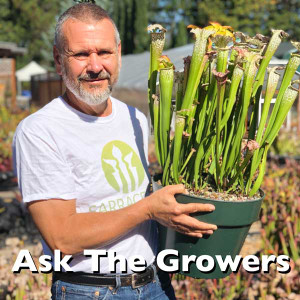February 15, 2023
Q/A #35 - Cape Sundew Is Dewless
QUESTION:
I purchased this Drosera capensis from Sarracenia Northwest six months ago. I live in Central Florida, and my Drosera sits inside on a windowsill. After I received the plant, I repotted with the recommended soil per your website (1 part peat and 1 part perlite). I have only used bottled distilled water and never any fertilizer. The plant did great and flourished until the past couple of months. It is turning brown from the bottom up as well as there isn’t nearly the amount of dew on the tips. Any advice or help would be greatly appreciated. Thanks!
(Submitted in February 2019.)

RESPONSE BY JEFF DALLAS:
Your plant looks perfectly normal, except it needs more sun than it's currently getting. I noticed the leaf tentacles are pink. With this variety of Cape sundew they should be a darker red. The amount of mucilage secretion is a sign of low light as well. Plants in strong light tend to have heavy drops.
You said it's in a windowsill, but didn't say how much sun it is getting. Ideally the plant should be in an unobstructed West or South window, If you tend to have more sun in the morning in FL, then and East window is good too. North windows do not work.
A sundew should be getting partial sun or about 4 hours of direct sun. Dappled sun is fine if it occurs throughout the daylight hours. If you can adjust the plant to get that, give it about a month and you should see a turn around. Also, plants tend to look poorer in winter because of short days and lots of clouds. Longer days will help too.
Since you live in Central Florida, you might even consider putting it outside in winter to get better sun. Perhaps in a semi-sheltered area where it can get some direct sunlight or dappled sun. Cape sundews also don't mind cool weather at all as long as it doesn't freeze. You would need to bring it in on frosty nights. Your temperatures are nearly identical to what it experiences in South Africa in winter. Summer is probably better indoors since your area is very hot.
The lower leaves dying off is very normal for this species. They get somewhat tree-like over time, and in nature they tend to have a scrambling habit on slopes.
• The original question and response have been edited for publication.
• With a database of thousands of questions, we will post a Q&A every few days or so.
• To search for similar posts, click on a hashtag below or use the site's search function.
• To submit a carnivorous plant question, visit Ask the Growers.

